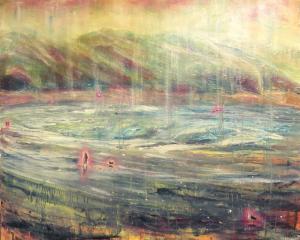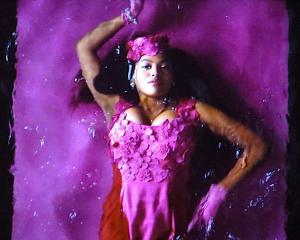In this week's Art Seen, art critic James Dignan looks at works by Peter Nicholls, Ralph Hotere, and Steev Peyroux.
 Leap, by Peter Nicholls.
‘‘Reflections’’, Peter Nicholls (Fe29 Gallery, St Clair)
Leap, by Peter Nicholls.
‘‘Reflections’’, Peter Nicholls (Fe29 Gallery, St Clair)

Peter Nicholls is Dunedin's pre-eminent sculptor of large-scale wooden and metal works, his constructions ranging from large public sculptures to intimate desktop pieces.
To celebrate the artist's 80th birthday, a retrospective of Nicholls' work is on display at Fe29.
Nicholls has employed a variety of styles over his years as a sculptor, many of which are well represented in this display.
The exhibition runs from one of his earliest works, the small bust Grace from 1963, through to large semi-abstract assemblages such as the geometric iron and ceramic form of Consensus.
The artist's impressive plays with light, the ``Shield'' and ``Canopy'' series, are well represented, these buckled metal wall hangings using the twin forms of metal and shadow to present their silhouetted avian forms.
New Zealand ecology and history are major influences in Nicholls' work, as are the traditions of the spiritual nature of different trees.
Several pieces are discreet nods to the land and human impact upon it, from the echoed topography of the hill-shaped Wilden to the Bridge Before and Bridge to Nowhere forms, two more pieces which play creatively with shadow.
Ecology comes to the fore in the small, beautiful works in swamp kauri and painted aluminium representing the interrelationship between native plant species and the farmers' curse, gorse.
 Black Rainbow at Matauri Bay, by Ralph Hotere.
‘‘Ralph Hotere’’ (Brett McDowell Gallery)
Black Rainbow at Matauri Bay, by Ralph Hotere.
‘‘Ralph Hotere’’ (Brett McDowell Gallery)

It is a rare pleasure these days to see a display of works by the late Ralph Hotere. To coincide with celebrations for the anniversary of the Frances Hodgkins Fellowship, Brett McDowell Gallery presents just such an exhibition.
The works on display range from small dynamic sketched portraits, among them the startling yet impressive Matisse-inspired Nude, through to substantially sized works such as the stately Black Painting XIIB from Malady (a poem by Bill Manhire), with its bold geometries and subtle yet evocative shades.
Among the standout works in the display is a painting dedicated to, and painted as a lament for, the then recently sunk Rainbow Warrior.
The stark monochromatic forms of Black Rainbow at Matauri Bay present a work that is both overwhelmingly sombre yet simultaneously filled with hope.
The titular rainbow and stark hand-written text dominate the picture space, but the eyes are drawn to the colours leaching from the rainbow to form a solid flame from which a phoenix/dove will rise again.
Another notable piece in the exhibition is one of Hotere's geometric black paintings, the solid wall of the canvas softened only by a precise cerise ring.
Within this, faint echoes of smaller concentric circles can be seen, like the memories implied by the growth rings of a fallen tree.
 Alone, by Steev Peyroux.
‘‘Perception’’, Steev Peyroux (The Artist’s Room)
Alone, by Steev Peyroux.
‘‘Perception’’, Steev Peyroux (The Artist’s Room)

Steev Peyroux first became known in the local art scene as a printmaker. His work in this medium concentrated largely on texture, his cliff faces and trees notable for their three-dimensional craggy nature.
Since moving to paint as a primary medium, the artist's work has until recently followed a similar theme. Peyroux's initial paintings were of a very similar nature to his prints.
He used roughly gessoed surfaces over which a smooth veneer of paint was laid to form strong, rough landforms. In more recent times, however, Peyroux has looked to cut back the texture to instead concentrate on the quality of light in his work.
In his latest exhibition, the artist has carried this approach to a new level by reducing the pictorial elements.
By removing the landscape and presenting only seas, sky, and the often imperceptible horizon at which they meet, Peyroux has switched the viewer's focus directly to the subtle interplay of shades and tones.
Closely observed skies and seas become a semi-abstract exploration of the artist's and viewers' perceptions.
The next logical step, presumably, would be sheer fields of slowly changing colour. Or maybe the artist will head in another direction entirely. Whichever he does, Peyroux's work is bound to remain both fascinating and compelling.






![... we all become all of these things [installation view] (2025), by Megan Brady.](https://www.odt.co.nz/sites/default/files/styles/odt_landscape_small_related_stories/public/story/2025/03/1_we_all_become_all_of_thes.jpg?itok=SH-Q8KJZ)


![Poipoia te Kākano [installation view]. Allison Beck, Megan Brady, Kate Stevens West, Jess...](https://www.odt.co.nz/sites/default/files/styles/odt_landscape_small_related_stories/public/story/2025/02/1_poipoia_te_k_kano.jpg?itok=_BEDlada)


